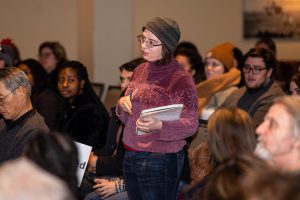Thanks to the popularity of the Netflix show Mindhunter, plenty of college-aged viewers have recently become interested in the infamous Atlanta child murders between 1979-1981.
The show’s second season, released last summer, centered on the case of Wayne Williams, who was charged with two of the 28 killings of black youths. He is also the suspect in most of the other cases. Mindhunter, a crime thriller series, has left viewers with questions about the conviction. Controversy around the investigation continues as there have been conspiracy theories that alleged white supremacist groups were involved. Williams, an African American, has maintained his innocence throughout the case.
On February 13, in front of a capacity crowd in the Old Main Room of the Bone Student Center, a renowned author and scholar offered up answers.
Dr. Adolph Reed Jr., a professor emeritus of political science at the University of Pennsylvania, delivered Illinois State University’s Black History Month keynote address on the murders that drove fear throughout Atlanta. The event was part of the Illinois State University Speaker Series and sponsored by the Office of the President and the Department of History.
Reed, who was working toward a doctorate at Atlanta University during the time of the murders, believes the right person is behind bars. He said the murders should not be looked at racially only, but also within the context of economic inequality.
“It’s possible to be progressive racially, with respect to shedding in the segregationism and the exclusions and stuff in the past, and to be openly and genuinely inclusive as a society,” Reed said. “But if the dynamics that produce economic inequality on a broader scale aren’t addressed, then you wind up with the same kind of contradictions that we could see in Atlanta in 1980.”
During this time, Atlanta was seen as a forward-thinking Southern city. Beginning in the 1960s corporations, such as Coca-Cola and Delta, had begun hiring black workers. The city had adapted an unofficial motto of “too busy to hate.” A mobilization of black voters helped elect the city’s first African American mayor, Maynard Jackson, in 1973. During the time of the murder spree, Reed served as the director of research and interns under Jackson.
Reed said Atlanta was an image-conscious city and saw its progressiveness stand out as a “beacon of black success” and prosperity.
But there was still a substantial poor population, Reed said, with a large percentage of black residents falling below the poverty line. While race tensions were certainly present, there also was economic tension within races, Reed said. For reference, Williams grew up in a black, middle-class household as the son of school teachers.
“The case crystallized anxieties concerning class and race and inequality, and how to think about them. At a moment when black political power was just being consolidated, when people didn’t quite know what the expectations were for what kind of transformation the black government would entail,” Reed said. “The conspiracy theories … sought to make sense of the killers in the framework of old horror stories of white supremacist violence.”
While terror was spreading all throughout Atlanta, many of the victims came from the city’s south and west sides. Reed said the victims’ most commonly shared characteristics besides race were poverty and precarious life circumstances.
Reed’s son, Dr. Touré Reed, is a professor in the Department of History at Illinois State. He introduced his father and shared what it was like being an African American child living in Atlanta at the time of the murders. He, too, connected the dots to class status.
“The missing and murdered children were on the first and clearest windows I had on the vulnerabilities engendered by poverty and inequality,” Touré Reed said. “It also made clear to me that your racial identity did not necessarily translate to decency, compassion, or camaraderie for group members. In this case, in fact, shared racial identity helped mask the evil intentions of the serial killer.”
The event ended with a 25-minute question-and-answer session with Adolph Reed. Many attendees approached him after the night’s conclusion, as well. It was a night of intrigue, dialogue, and active engagement while taking a broad look at an American tragedy that has made its way into pop culture.


